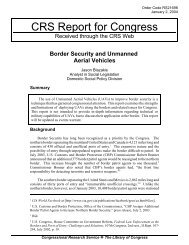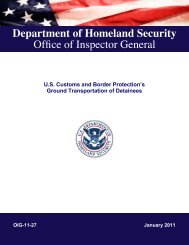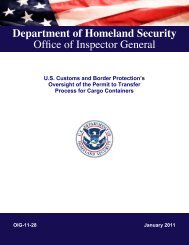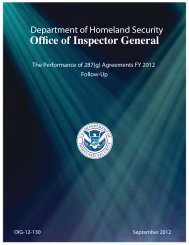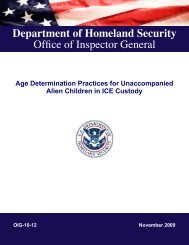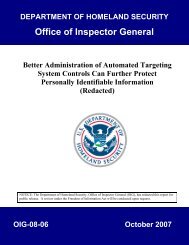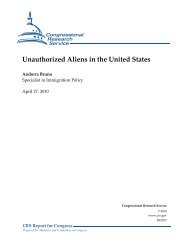Asylum and "Credible Fear" Issues in U.S. Immigration Policy
Asylum and "Credible Fear" Issues in U.S. Immigration Policy
Asylum and "Credible Fear" Issues in U.S. Immigration Policy
Create successful ePaper yourself
Turn your PDF publications into a flip-book with our unique Google optimized e-Paper software.
<strong>Asylum</strong> <strong>and</strong> “<strong>Credible</strong> Fear” <strong>Issues</strong> <strong>in</strong> U.S. <strong>Immigration</strong> <strong>Policy</strong>Approvals by Regional Office <strong>and</strong> <strong>Immigration</strong> CourtResearch studies of the approval rates of cases filed by asylum seekers consistently revealdisparities by USCIS regional asylum offices <strong>and</strong> EOIR immigration courts. Fredric N. Tulsky ofthe San Jose Mercury News was a f<strong>in</strong>alist for the Pulitzer Prize for <strong>in</strong>vestigative report<strong>in</strong>g <strong>in</strong> 2001“for his illum<strong>in</strong>at<strong>in</strong>g report<strong>in</strong>g on the arbitrary <strong>and</strong> <strong>in</strong>consistent adm<strong>in</strong>istration of the federalsystem that grants political asylum.” 55 In 2006, researchers at Syracuse University’s TransactionalRecords Access Clear<strong>in</strong>ghouse (TRAC) found “a surpris<strong>in</strong>g lack of consistency” among similarlysituated asylum cases considered by EOIR from FY1994 to the early months of FY2005. 56 TheStanford Law Review published “Refugee Roulette: Disparities <strong>in</strong> <strong>Asylum</strong> Adjudication” <strong>in</strong> 2007,which analyzed decisions of USCIS asylum officers as well as EOIR immigration judges. 57Refugee RouletteThe example of asylum seekers from the PRC offers strik<strong>in</strong>g differences <strong>in</strong> the percentage ofcases approved across regions <strong>and</strong> jurisdictions, despite national data trends that appearedconsistent. A study of 290 asylum officers who decided at least 100 affirmative cases from thePRC from FY1999 through FY2005 found that the approval rate of PRC claimants spanned fromzero to over 90% dur<strong>in</strong>g this period. In one regional asylum office, the grant rates for affirmativeapplications from the PRC varied from zero to 68%. Sixty percent of the officers <strong>in</strong> that regionaloffice deviated from their office’s average PRC asylum approval rates by more than 50%. 58Nationwide, immigration judges granted asylum to 47% percent of defensive cases of PRCclaimants from January 1, 2000, through August 31, 2004, but exhibited a pattern of variationsimilar to the USCIS asylum officers when the cases were broken down by court. Theimmigration court <strong>in</strong> Atlanta approved 7% of defensive PRC cases; however, the court <strong>in</strong>Orl<strong>and</strong>o, FL, approved 76% of defensive cases from PRC claimants. The disparity cont<strong>in</strong>ued ifthe applicant lost at the Board of <strong>Immigration</strong> Appeals <strong>and</strong> petitioned for review <strong>in</strong> the U.S. Courtof Appeals. From FY2003 to FY2005, the Fourth Circuit did not rem<strong>and</strong> a s<strong>in</strong>gle case from thePRC (i.e., the court never decided <strong>in</strong> favor of the applicant), while the N<strong>in</strong>th Circuit rem<strong>and</strong>ed <strong>in</strong>37% of the PRC cases. 59The authors of this extensive study of affirmative <strong>and</strong> defensive decisions, “Refugee Roulette:Disparities <strong>in</strong> <strong>Asylum</strong> Adjudication,” offered the follow<strong>in</strong>g observations:<strong>Asylum</strong> seekers from three of these countries faced a grant rate <strong>in</strong> at least one court that wasmore than 50% below the national average, <strong>and</strong> applicants from four of these countriesenjoyed a grant rate <strong>in</strong> at least one court that was more than 50% above the nationalaverage.... For one of these countries, Ch<strong>in</strong>a, the high grant rate <strong>and</strong> the low grant ratedeviated by more than 50% from the national average.... Colombian asylum seekers alsofaced major disparities: those who appeared before the Orl<strong>and</strong>o <strong>Immigration</strong> Court had a55 The Pulitzer Prizes, “2001 F<strong>in</strong>alists Journalism,” press release, 2001, http://www.pulitzer.org/f<strong>in</strong>alists/2001.56 Transactional Records Access Clear<strong>in</strong>ghouse, <strong>Immigration</strong> Judges: <strong>Asylum</strong> Seekers <strong>and</strong> the Role of the <strong>Immigration</strong>Court, Syracuse University, July 2006, http://trac.syr.edu/immigration/reports/160/.57 Jaya Ramji-Nogales, Andrew I. Schoenholtz, <strong>and</strong> Phillip G. Schrag, “Refugee Roulette: Disparities <strong>in</strong> <strong>Asylum</strong>Adjudication,” Stanford Law Review, vol. 60, no. 2 (November 2007).58 Ibid.59 Ibid.Congressional Research Service 25



